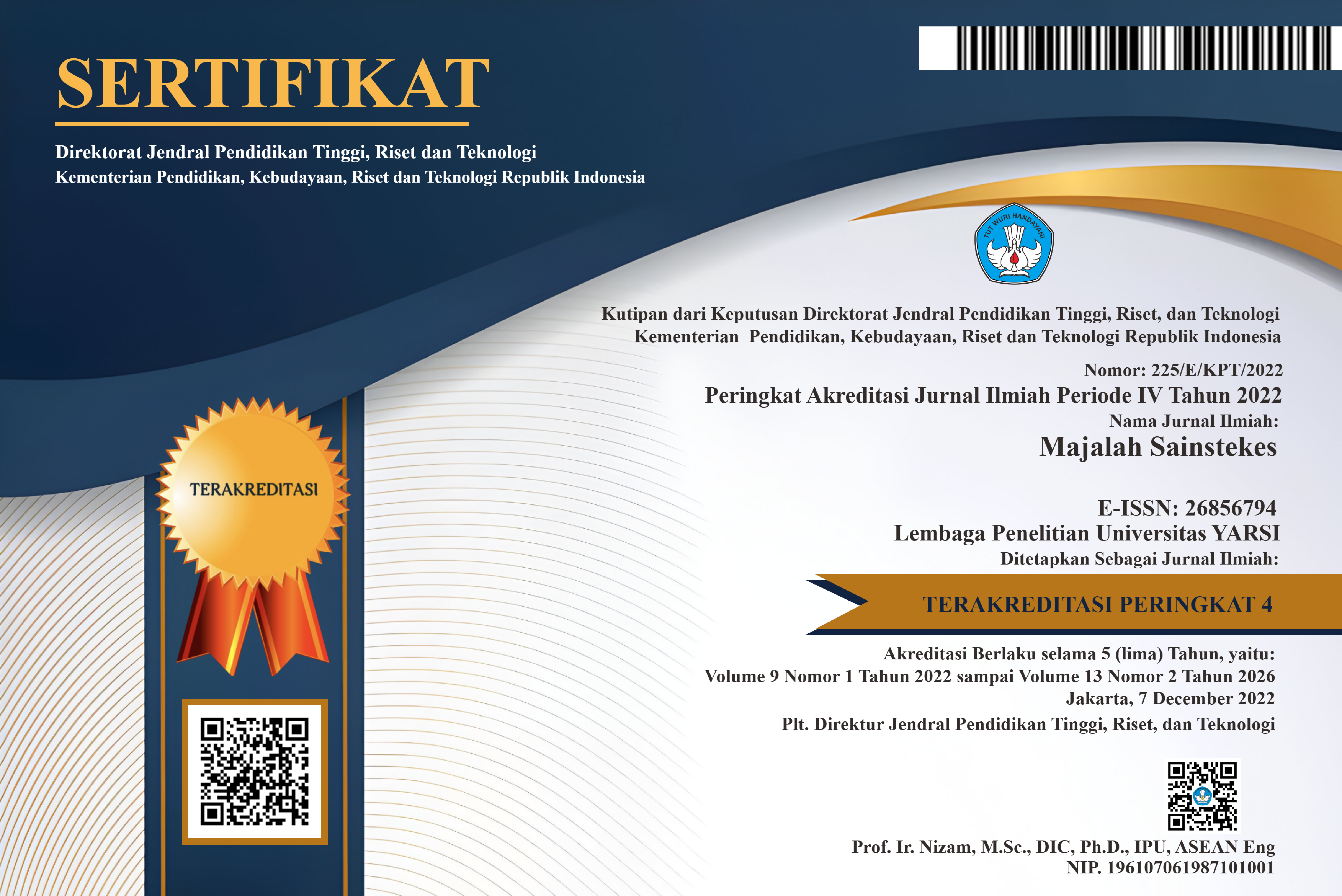Perbedaan Analisis Sefalometri Skeletal Sebelum dan Sesudah Perawatan Alat Myofunctional pada Pasien Maloklusi Dentoskeletal Kelas II Divisi I dalam Masa Pertumbuhan dengan Metode Steiner
Keywords:
chepalometrics analysis, myofunctional appliances, dentoskeletal class II division 1 malocclusion, Steiner methodAbstract
The aim of orthodontics treatment is normalization of teeth position in three planes, using various orthodontics appliance to reach the chepalometric standar and normal occlusion. Orthodontic treatment for dentoskeletal class II division 1 malocclusion in growing patients using myofunctional appliance may correct anteroposterior planes of mandibula. This study was a descriptive retrospective analytic study to look at the success of Orthodontic treatment for dentoskeletal class II division 1 in growing patients with myofunctional appliance using chepalometrics analysis Steiner value. The sample used in this study is chepalogram radiographic from patient with dentoskeletal class II division 1 malocclusion in growing patients before and after using myofunctional appliance in PPDGS orthodontics Clinic of Padjadjaran University. Statistic analysis were performed with pair t-test and Wilcoxon. Based on this study, it is concluded that orthodontic treatment with myofunctional appliance such as activator and twin block in growing patient with dentoskeletal class II division 1 malocclusion shows significant changes and compatibility with the normal criteria.References
Alam, MK. 2012. A to Z Orthodontics: Functional Orthodontic Appliance. Universiti Sains Malaysia. Kelantan, Malaysia. (Diunduh 23 April 2014) https://dralamusm.files.wordpress.com/2
/12/a-to-z-orthodontics-vol-11- functional-orthodontic-appliances.pdf
Andrews, LF. 1972. The Six Keys to Normal Occlusion. Am J Orthod 63:296-302.
Antonarakis, GS. & Kiliaridis, S. 2007. Short-term Anteroposterior Treatment Effects of Functional Appliances and Extraoral Traction on Class II Malocclusion. Angle Orthod;77(5):907-914
Baccetti, T., dkk. 2000. Treatment Timing for Twin Block Therapy. Am J Orthod Dentofacial Orthop;118(2):159-170
Bhattarai, P. & Shrestha, RM. 2011. Tweed Analysis of Nepalese People. Nepal Med Coll J;13:103-106
Cistullli, PA., Gotsopoulos, H., Sullivan, CE. 2001. Relationship Between Craniofacial Abnormalities and Sleep-Disordered Breathing in Marfan’s Syndrome. Chest Journal;120(5):1455-1460
Covell, DA., dkk. 1999. A Chephalometric Study of Class II Division 1 Malocclusions Treated with Jasper Jumper Appliance. Angle Orthod;69(4):311-320
Dentistry and Medicine. 2011. Functional Appliances Orthodontic Lecture Note. (Diunduh 23 April 2014) http://dentistryandmedicine.blogspot.com/2011/09/functional-appliances- orthodontic.html
Fishman, LS. 1982. Maturational Patterns and Prediction During Adolescence. Angle Orthod;87:178-193
Hashim, HA. & Al-Balkhi, K. 2002. Soft Tissue Relation and Tweed Triangle in a Saudi Sample. Pakistan Oral & Dent J;22:127-132
Jacobson, A. 1995. Radiographic Chepalometry : from Basic to Video Imaging. Quintessence Pub. Co Inc :65-86
Kuramae, M., dkk. 2004. Analysis of Tweed’s Facial Triangle in Black Brazilian Youngsters with Normal Occlusion. Braz J Oral Sci;3:401-403
McNamara, JA. & Brudon, WL. 1994.
Orthodontic and Orthopedic Treatment in the Mixed Dentition. Ann Arbor : Needham Press :95-116
Mitchell, L. 2007. An Introduction to orthodontics. New York : Oxford University Press Inc
Moyers, RE. 1988. Handbook of Orthodontics. 4th ed. New York: Oxford University Press Inc : 187-188
Nanda, R. & Kapila, S. 2010. Current Therapy in Orthodontics. St. Louis: Mosby Inc: 88
Patel, HP., Moseley, HC., Noar, JH. 2002. Cephalometric Determinants of Successful Functional Appliance Therapy. Angle Orthod;72:410–417
Proffit, WR., dkk. 2013. Contemporary Orthodontics. 5th ed. St. Louis: Mosby Inc
Rakosi, T., dkk., 1993. Color Atlas of Dental Medicine: Orthodontic Diagnosis. Stuttgart; George Thieme Verlag KG: 179-206
Richmond, S., Klufas, M. & Sywanyk, M. 1998. Assessing Incisor Inclination: A Non-evasive Technique. Eur J Orthod;20:721-726
Sachan, K., dkk. 2011. A Correlative Study of Dental Age and Skeletal Maturation. Indian Journal of Dental Research;22(6):882
Siara-Olds, NJ., Pangrazio-Kulbersh, V., Berger, J., Bayirli, B. 2010. Long- Term Dentoskeletal Changes with the Bionator, Herbst, Twin Block, and MARA Functional Appliances. Angle Orthod;80:18–29
Soemantri, ESS. 1999. Sefalometri. Universitas Padjadjaran. Bandung. Steiner, CC. 1959. Chepalometrics in Clinical Practice. Angle Orthod ; 29(1):8–29
Tong, H., dkk. 2012. A New Method to Measure Mesiodistal Angulation and Faciolingual Inclination of Each Whole Tooth with Volumetric Cone-beam Computed Tomography Images. Am J Orthod Dentofacial Orthop;142:133-43
Tweed, CH. 1966. Clinical Orthodontics, The C.V. Mosby Co., St. Louis.
Ursi, WJS., dkk. Assessment of Mesiodistal Axial Inclination Through Panoramic Radiography. J Clin Orthod;24:166-173
Usumez, R., dkk. 2004. The Effects of Early Preorthodontic Trainer Treatment on Class II Division 1 Patients. Angle Orthod ;74:605–609
Williams, S. & Andersen, CE. 1995. Incisor Stability in Patients with Anterior Rotational Mandibular Growth. Angle Orthod;65:431-44

 Nugroho Ahmad Riyadi
Nugroho Ahmad Riyadi












